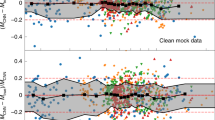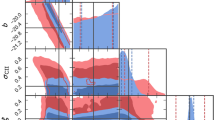Abstract
We propose a deep learning analysis technique with a convolutional neural network (CNN) to predict the evolutionary track of the Epoch of Reionization (EoR) from the 21-cm differential brightness temperature tomography images. We use 21cmFAST, a fast semi-numerical cosmological 21-cm signal simulator, to produce mock 21-cm maps between z = 6–13. We then apply two observational effects, such as instrumental noise and limit of (spatial and depth) resolution somewhat suitable for realistic choices of the Square Kilometre Array (SKA), into the 21-cm maps. We design our deep learning model with CNN to predict the sliced-averaged neutral hydrogen fraction from the given 21-cm map. The estimated neutral fraction from our CNN model has great agreement with the true value even after coarsely smoothing with broad beam size and frequency bandwidth and heavily covered by noise with narrow beam size and frequency bandwidth. Our results show that the deep learning analyzing method has the potential to reconstruct the EoR history efficiently from the 21-cm tomography surveys in future.
Similar content being viewed by others
References
J. Miralda-Escude, Science 300, 1904 (2003); astroph/0307396.
S. R. Furlanetto and S. P. Oh, Mon. Not. R. Astron. Soc. 363, 1031 (2005); astro-ph/0505065.
X. Fan et al., Astron. J. 132, 117 (2006), astroph/0512082.
O. Zahn et al., Astrophys. J. 756, 65 (2012); 1111.6386.
Planck Collaboration et al., Astron. Astrophys. 596, A108 (2016); 1605.03507.
M. J. Mortonson and W. Hu, Astrophys. J. 672, 737 (2008); 0705.1132.
K. Ahn et al., Astrophys. J. Lett. 756, L16 (2012); 1206.5007.
C. H. Heinrich, V. Miranda and W. Hu, Phys. Rev. D 95, 023513 (2017); 1609.04788.
S. J. Tingay et al., Publ. Astron. Soc. Aust. 30, e007 (2013); 1206.6945.
G. Paciga et al., Mon. Not. R. Astron. Soc. 413, 1174 (2011); 1006.1351.
M. P. van Haarlem et al., Astron. Astrophys. 556, A2 (2013); 1305.3550.
A. R. Parsons et al., Astron. J. 139, 1468 (2010); 0904.2334.
D. R. DeBoer et al., Publ. Astron. Soc. Pac. 129, 045001 (2017); 1606.07473.
P. E. Dewdney, P. J. Hall, R. T. Schilizzi and T. J. L. W. Lazio, IEEE Proc. 97, 1482 (2009).
L. Koopmans et al., in Advancing Astrophysics with the Square Kilometre Array (AASKA14), SISSA Medialab (2015), p. 1; 1505.07568.
S. R. Furlanetto, S. P. Oh and F. H. Briggs, Phys. Rep. 433, 181 (2006); astro-ph/0608032.
M. F. Morales and J. S. B. Wyithe, Annu. Rev. Astron. Astrophys. 48, 127 (2010); 0910.3010.
S. Zaroubi, The Epoch of Reionization (2013), vol. 396 of Astrophysics and Space Science Library, Springer-Verlag Berlin Heidelberg, p. 45.
T. Di Matteo, R. Perna, T. Abel and M. J. Rees, Astrophys. J. 564, 576 (2002); astro-ph/0109241.
M. Zaldarriaga, S. R. Furlanetto and L. Hernquist, Astrophys. J. 608, 622 (2004); astro-ph/0311514.
F. H. Briggs and J. Kocz, Radio Sci. 40, RS5S02 (2005).
X. Wang, M. Tegmark, M. G. Santos and L. Knox, Astrophys. J. 650, 529 (2006); astro-ph/0501081.
C. Schaefer, M. Geiger, T. Kuntzer and J. P. Kneib, Astron. Astrophys. 611, A2 (2018); 1705.07132.
N. Gillet et al., Mon. Not. R. Astron. Soc. 484, 282 (2019); 1805.02699.
J. Seiler, A. Hutter, M. Sinha and D. Croton, Mon. Not. R. Astron. Soc. 487, 5739 (2019); 1902.01611.
J. Chardin et al., Mon. Not. R. Astron. Soc. 490, 1055 (2019); 1905.06958.
F. List and G. F. Lewis, Mon. Not. R. Astron. Soc. 493, 5913 (2020); 2002.07940.
H. J. Hortua, L. Malago and R. Volpi, arXiv e-prints arXiv:2005.07694 (2020); 2005.07694.
P. La Plante and M. Ntampaka, Astrophys. J. 880, 110 (2019); 1810.08211.
H. Shimabukuro and B. Semelin, Mon. Not. R. Astron. Soc. 468, 3869 (2017); 1701.07026.
S. Hassan, A. Liu, S. Kohn and P. La Plante, in The 34th Annual New Mexico Symposium, edited by A. D. Kapinska, National Radio Astronomy Observatory, 9 Nov, 2018; p. 7.
A. Mesinger, S. Furlanetto and R. Cen, Mon. Not. R. Astron. Soc. 411, 955 (2011); 1003.3878.
Planck Collaboration et al., arXiv e-prints arXiv:1807.06209 (2018); 1807.06209.
J. R. Bond, S. Cole, G. Efstathiou and N. Kaiser, Astrophys. J. 379, 440 (1991).
S. R. Furlanetto, M. Zaldarriaga and L. Hernquist, Astrophys. J. 613, 1 (2004); astro-ph/0403697.
Y. B. Zel’Dovich, Astron. Astrophys. 500, 13 (1970).
J. Park, A. Mesinger, B. Greig and N. Gillet, Mon. Not. R. Astron. Soc. 484, 933 (2019); 1809.08995.
G. Mellema, I. T. Iliev, U.-L. Pen and P. R. Shapiro, Mon. Not. R. Astron. Soc. 372, 679 (2006); astro-ph/0603518.
S. E. Hong et al., J. Korean Astronom. Soc. 47, 49 (2014); 1008.3914.
Y. Wang et al., Astrophys. J. 814, 6 (2015); 1510.01404.
I. T. Iliev, E. Scannapieco, H. Martel and P. R. Shapiro, Mon. Not. R. Astron. Soc. 341, 81 (2003); astro-ph/0209216.
J. Asorey et al., arXiv e-prints arXiv:2001.00833 (2020); 2001.00833.
R. H. R. Hahnloser et al., Nature 405, 947 (2000).
X. Glorot, A. Bordes and Y. Bengio, in Proceedings of the fourteenth international conference on artificial intelligence and statistics (Fort Lauderdale, FL, USA, April 11–13, 2011), pp. 315–323.
K. He, X. Zhang, S. Ren and J. Sun, arXiv e-prints arXiv:1502.01852 (2015); 1502.01852.
S. Ioffe and C. Szegedy, arXiv e-prints arXiv:1502.03167 (2015); 1502.03167.
D. P. Kingma and J. Ba, arXiv e-prints arXiv:1412.6980 (2014); 1412.6980.
F. Chollet et al., Keras, https://keras.io (2015).
M. Abadi et al., TensorFlow: Large-scale machine learning on heterogeneous systems (2015), software available from tensorflow.org, URL https://www.tensorflow.org/.
A. Liu and A. R. Parsons, Mon. Not. R. Astron. Soc. 457, 1864 (2016); 1510.08815.
Acknowledgments
The authors thank Kyungjin Ahn, Hyunbae Park, Dongsu Bak, Sangnam Park, David Parkinson, Jacobo Asorey, and an anonymous reviewer for helpful discussion and comments. The authors were supported by the Basic Science Research Program through the National Research Foundation of Korea funded by the Ministry of Education (2018R1A6A1A06024977). Computational data were transferred through a high-speed network provided by the Korea Research Environment Open NET-work (KREONET).
Author information
Authors and Affiliations
Corresponding author
Rights and permissions
About this article
Cite this article
Kwon, Y., Hong, S.E. & Park, I. Deep-Learning Study of the 21-cm Differential Brightness Temperature During the Epoch of Reionization. J. Korean Phys. Soc. 77, 49–59 (2020). https://doi.org/10.3938/jkps.77.49
Received:
Revised:
Accepted:
Published:
Issue Date:
DOI: https://doi.org/10.3938/jkps.77.49




